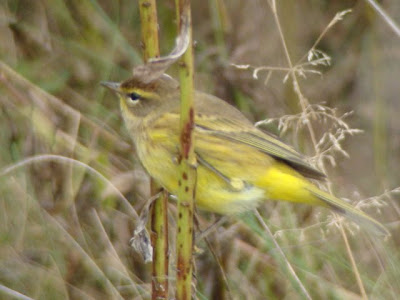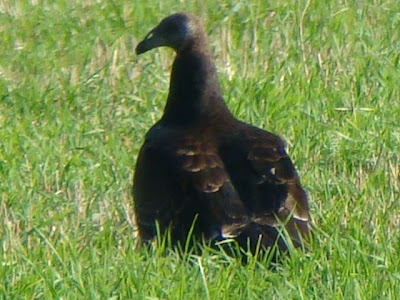The winds finally stopped blowing up here last night so I decided to head over to the Burnt-Rossman Hills State Forest to check on the Red Crossbills that were there and after that take a ride through farm country to see if anything intersting was going on. The weather forecast was for some accumulating snow in the afternoon and that was just what I was looking for.

Burnt-Rossman is an intersting piece of state forest. It's considered large for a piece of state land outside the Adirondack or Catskill forest preserves. It's difficult to find much information on it as there are no kiosks or maps and I litterally stumbled upon it one day years ago while out driving and have enjoyed birding it ever since.

Even the DEC isn't quite sure how big of a parcel it is, as these two signs are about a mile apart from each other. This is the kind of thing that drives surveyors nuts. One thing is for sure, the taxman knows exactly how big of a parcel it really is.

One of the first birds that I spotted was this Ruffed Grouse strutting around on a snow covered forest road. Another bird was on the edge of the road and that was probably why he was acting so territorial. It's not unusual to hear them drumming or see them acting territorial in the winter.

It didn't take long to find the crossbills. They were in the same general area where they had been hanging out for the couple of months. Not a lot of them, that's for sure. Last weekend my curiosity was really piqued when I found a pair and the male actually was singing. They have an incredible song that is quite elaborate for a winter finch.

There was actually some sun out during the early morning hours and this female was spotted in a nearby hardwood.

3 more were spotted across the road on top of a Norway Spruce. It's always amazed me at how quiet crossbills can be when they want to. You get the feeling that someone or something is watching you, so you turn around and there they are. These birds were completely silent and did not make a sound until they eventuall flew back deeper in the forest.

This is what I really wanted to see. In the past few months I had only observed them feeding on the cones of some of the European Larch that is planted there. According to what I've read, larch is not the prefered food of the larger billed Red Crossbills as it is very hard for them to manipulate such a small cone with a beak that is designed for larger cones. I was happy to see that this crossbill had found some of the abundant White Pine cones in the area and was feasting on them. There is an excellent White Pine crop in the area and perhaps this will encourage them to stick around.

I found this Northern Shrike along the side of the road once I had left the state forest. It was clouding up in a hurry and the lighting wasn't that great.

And then it was off to farm country as the storm approached. When the snow finally arrives, the fieldbirds come out to the edge of the road to try and find something to eat.


The flock was mainly Horned Larks, but after some careful scrutiny I was able to find a Lapland Longspur in the group.

A few moments later I realized that there was another longspur in the flock. It was snowing pretty hard at this point and the birds seemed to be frantic.

It sure is hard to get a decent picture with so many snowflakes in the air.

Longspurs are very abundant on the arctic tundra in the summer. Hard to believe that they come down here to the "sunny south" to spend the winter. I think I would keep heading south!

A little further down the road, I spotted some geese in a field on top of a knoll. It was snowing so hard that at first I thought there were just some Canada Geese in a field with some clumps of snow behind them.

A closer look revealed that there was actually a flock of Snow Geese on the top of the hill. They were probably grounded once the heavy snow began.

I wish the visibility was a little better, but then again the reason that the birds had landed was the snow. Guess I shouldn't complain.


Burnt-Rossman is an intersting piece of state forest. It's considered large for a piece of state land outside the Adirondack or Catskill forest preserves. It's difficult to find much information on it as there are no kiosks or maps and I litterally stumbled upon it one day years ago while out driving and have enjoyed birding it ever since.

Even the DEC isn't quite sure how big of a parcel it is, as these two signs are about a mile apart from each other. This is the kind of thing that drives surveyors nuts. One thing is for sure, the taxman knows exactly how big of a parcel it really is.

One of the first birds that I spotted was this Ruffed Grouse strutting around on a snow covered forest road. Another bird was on the edge of the road and that was probably why he was acting so territorial. It's not unusual to hear them drumming or see them acting territorial in the winter.

It didn't take long to find the crossbills. They were in the same general area where they had been hanging out for the couple of months. Not a lot of them, that's for sure. Last weekend my curiosity was really piqued when I found a pair and the male actually was singing. They have an incredible song that is quite elaborate for a winter finch.

There was actually some sun out during the early morning hours and this female was spotted in a nearby hardwood.

3 more were spotted across the road on top of a Norway Spruce. It's always amazed me at how quiet crossbills can be when they want to. You get the feeling that someone or something is watching you, so you turn around and there they are. These birds were completely silent and did not make a sound until they eventuall flew back deeper in the forest.

This is what I really wanted to see. In the past few months I had only observed them feeding on the cones of some of the European Larch that is planted there. According to what I've read, larch is not the prefered food of the larger billed Red Crossbills as it is very hard for them to manipulate such a small cone with a beak that is designed for larger cones. I was happy to see that this crossbill had found some of the abundant White Pine cones in the area and was feasting on them. There is an excellent White Pine crop in the area and perhaps this will encourage them to stick around.
I think this guy has found what he was looking for. Time will tell.

I found this Northern Shrike along the side of the road once I had left the state forest. It was clouding up in a hurry and the lighting wasn't that great.

And then it was off to farm country as the storm approached. When the snow finally arrives, the fieldbirds come out to the edge of the road to try and find something to eat.

At one intersection, I found a group of "snowbirds" frantically foraging.

The flock was mainly Horned Larks, but after some careful scrutiny I was able to find a Lapland Longspur in the group.

A few moments later I realized that there was another longspur in the flock. It was snowing pretty hard at this point and the birds seemed to be frantic.

It sure is hard to get a decent picture with so many snowflakes in the air.

Longspurs are very abundant on the arctic tundra in the summer. Hard to believe that they come down here to the "sunny south" to spend the winter. I think I would keep heading south!

A little further down the road, I spotted some geese in a field on top of a knoll. It was snowing so hard that at first I thought there were just some Canada Geese in a field with some clumps of snow behind them.

A closer look revealed that there was actually a flock of Snow Geese on the top of the hill. They were probably grounded once the heavy snow began.

I wish the visibility was a little better, but then again the reason that the birds had landed was the snow. Guess I shouldn't complain.

There were both adults and immatures mixed in the flock. I looked through the flock as best I could given the conditions. Nothing but Snow Geese were found and I decided to move on and stop back later once the fast moving storm had stopped. I stopped back about an hour later and all that was there were the Canada Geese. Just a short delay in their plan and they were off again.






































